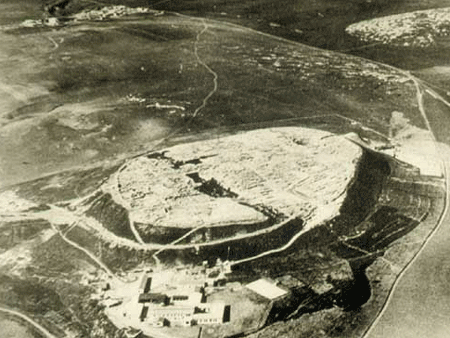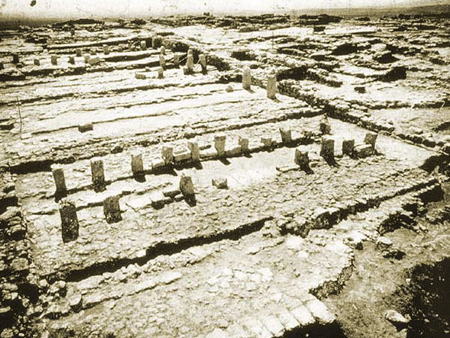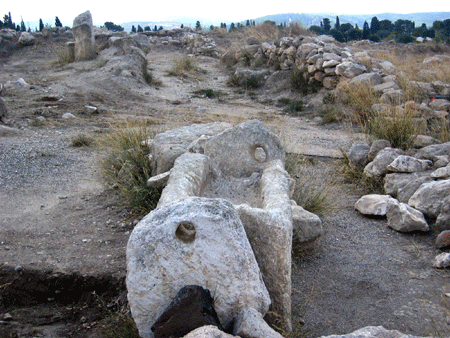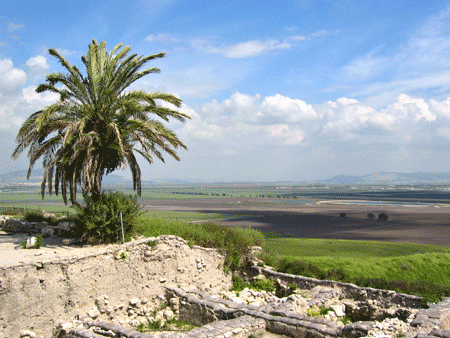|
Wise old king Solomon was a man of contrasts.
He was a man of peace. (His Hebrew name,
Shlomo, even means peace.) Yet Solomon built a
formidable war machine which included 40,000 stalls
for chariot-horses and 12,000 horsemen. (First Kings
4:26) (There is, however, a discrepancy in the
number of stalls built for Solomon’s horses: Second
Chronicles 9 gives the figure as only 4,000,
rather than 40,000.) |
|
|
|
Solomon’s horses were imported from Egypt and Kue,
perhaps a region in Turkey. And Solomon’s
neighboring allies would contribute even more horses
as annual tribute, in addition to gold and silver,
weapons and spices. |
|
|
|
 |
|
Adapted from map on Internet
for Learning site |
|
Map of northern Israel showing the
location of Megiddo |
|
|
|
It’s said in First Kings chapter 9, verse 15, that
Solomon built the cities of Hatzor, Gezer and
Megiddo, probably using the same architects and
building engineers.
Were these the chariot cities referred to in
Second Chronicles 9:25 where the horses and chariots
were stored? We think so.
|
|
|
|
 |
|
Courtesy of the
Megiddo Expedition |
|
Aerial photo of Tel Megiddo taken
by balloon in 1931 |
|
|
|
From 1925 to 1939, Megiddo was excavated by an
expedition from the University of Chicago. The
archeologists, using hired labor from a nearby
village, discovered tall pillars and trough-like
“mangers” which they identified as stables.
Well – if they are stables, then obviously, based
upon the Bible, they were built by Solomon, the
American excavators concluded. |
|
|
|
 |
|
Courtesy of the
Megiddo Expedition |
|
Local laborers climbing up Tel
Megiddo to excavate in the 1930s |
|
|
|
 |
|
Courtesy of the
Megiddo Expedition |
|
Northern Iron Age stables,
removed in the 1920s |
|
|
|
 |
|
Photo: Gila
Yudkin |
|
Area of the northern stables in
2009 |
|
|
|
When I studied to be a guide in 1977, we learned
that there were stables for 450 horses at Megiddo.
Today, after the excavations starting in 1992, it’s
believed that there are a lot more. But it’s
no longer certain that they are ‘Solomon’s’ stables.
In fact, the majority of excavators from Tel Aviv
University believe that the stables are either ninth
or eighth century BC, dated to the Israelite Kingdom
ruled by Ahab or King Jeroboam the second. |
|
|
|
 |
|
Photo: Gila
Yudkin |
|
A trough or "manger" found in the
stables at Megiddo |
|
|
Last October I attended a full day seminar for
guides at Megiddo with archeologist
Dr. Norma Franklin who shared discoveries,
controversies, gossip and anecdotes of her 18
seasons of excavation on the site. The first
thing she told us is that she dates what we call the
“Solomonic gates” to two hundred years later, to the
8th century BC, to the time of Jeroboam the second.
|
|
|
 |
Dr. Franklin doesn’t believe that the stables of
Solomon’s day have been found (yet!). However
she picked up and showed us a mud-brick from the
time of Solomon, 10th century BC. (left photo)
The most thrilling part of the seminar was when Dr.
Franklin shared some new research with us about
horses and stables. It was roughly the time of the
patriarchs, about 1700 BC, when the Hyksos brought
the first horses from Asia Minor to Egypt. The
Egyptians immediately learned to manipulate the
horses and brought them to Nubia for breeding.
Nubia is located in the south of Egypt along the
Nile River and in northern Sudan.
The Egyptians attached the horses to chariots and
used them in both war and peace. The original
chariot was a fast, light, open, two or four-wheeled
carriage |
|
Photo: Gila
Yudkin |
drawn by two or more horses hitched
|
|
Dr. Franklin with a Solomonic mud-brick |
side by side. |
|
|
|
A thousand years later, by 750 BC, the Nubians had
become famous horse-breeders. Many foreign kings,
particularly from Assyria and Babylon, wanted Nubian
horses and their grooms. One of the better
known Nubian kings, Piankhy had several walls of his
temple decorated with painted processions of horses
he had received as gifts from the rulers of Egypt.
He even had his favorite horses buried with him so
they could accompany the king to the afterlife.
Many Nubian royal tombs have horses buried in them
or beside them! |
|
|
|
So what is the connection with Megiddo? |
|
|
|
Apparently the northern kingdom of Israel was an
important link in the chariot-horse trade. In
the Israelite chariot cities, the horses were
trained in tandem for racing. Chariot horses need to
live cheek to jowl, right next to each other.
This is in fact counter-intuitive for a horse, which
naturally prefers an open area and lots of space.
|
|
|
|
According to Dr. Franklin, the dimensions of the
stables at Megiddo are a perfect match for training
the relatively large Nubian horses to adjust to the
claustrophobic conditions of chariot driving.
If a horse was trained for chariot racing, then the
sale value of that horse would increase ten-fold,
for example, from $100 to $1,000 per horse. |
|
|
|
 |
|
Courtesy of the
Library of Congress |
|
Nubian horses photographed by
Roger Fenton around 1855 |
|
|
|
In a presentation called “A Kingdom for a Horse,”
Megiddo excavation director Professor Israel
Finkelstein proposed that Megiddo was a center for
one of the most lucrative “cash-crop” industries of
the Northern Kingdom. In the 8th century BC
(contemporary to the time of the Prophet Isaiah),
Israel was the intermediary between the famed Nubian
horse industry from Egypt and the Assyrian
imperialist superpower in Mesopotamia. Megiddo
became the major center for breeding and training
these horses. |
|
|
|
Extensive stables in the northern part of Tel
Megiddo were removed by the University of Chicago
excavators in the 1920s. But as we tour
Megiddo, we will walk through the southern stables.
|
|
|
|
 |
|
Courtesy of the
Megiddo Expedition |
|
Southern stables (Area L)
excavated by the Tel Aviv University expedition |
|
|
|
Archeologists recently took samples of dirt from
this area (Area L) and sent them to the laboratory
to test for traces of horse urine which has a
specific PH. The samples came back positive.
Then, just to compare, they took dirt from other
parts of the tel where there were no stables and
they came back with traces of horse urine as well!
Conclusion: Megiddo’s foremost mission in the
Israelite period was to train horses for battle. |
|
12 MOST
POPULAR ARTICLES this month |
|
|
And what about Solomon’s stables? According to
the present excavators, stables from the tenth
century BC have not yet been found. But, as
Dr. Franklin puts it, “An absence of evidence is NOT
evidence of absence!”
|
|
And as for Solomon’s dad’s perspective on horses and
chariots, let’s look at Psalm 20, verse 7. “Some
take pride in a chariot, and others in horses, but
we take pride in the name of the Lord our God!” |
|
|
|
 |
|
Photo: Gila
Yudkin |
|
Megiddo Chariot! |
|
|
|
On your next trip to Israel, come with me to
Megiddo, a rich site where we can discuss horses and
chariots, Solomon and Josiah, the Canaanites and the
Israelites, and of course the Battle of Armageddon! |
|
|
|
Copyright 2009 Gila Yudkin. Permission
needed for any reuse. |
|
|
|
 |
|
Photo: Gila
Yudkin |
|
The Valley of Armageddon lies
below Tel Megiddo |
|
|
|
Gila Yudkin
is a Connecticut-born Yankee living in King David’s
Court. She loves sharing new research which
provides insight into biblical passages. On
tour, Gila mixes fun, fantasy and facts with passion
for archeology and Bible. She recently
received an email from a subscriber to Holy Sites –
Gila’s Highlights saying, “We toured with you in
1998. It's #1 on my list of favorite things I
have ever done.” |
|
|

